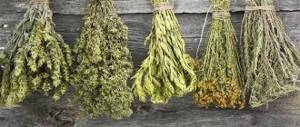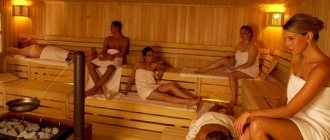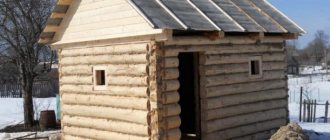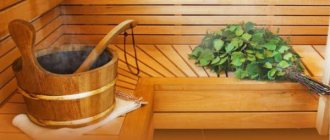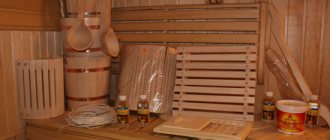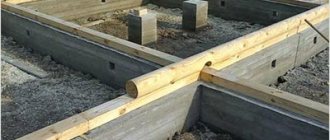In addition to fast driving, vodka and red caviar, every Russian loves the bathhouse. We can say that the bathhouse is an original Russian symbol, taking its roots in ancient times. Many people simply cannot afford to have their own bathhouse, so a special niche for the bathhouse business has emerged. Private paid baths, saunas, steam rooms are no longer new. However, the lion's share of income in this business comes not from visiting the establishment itself, but from the sale of accessories. What can’t you do without in a bath? Right! Without a broom. That is why making bath brooms is a very profitable business.
Brief business analysis: Costs of organizing a business: 20 - 30 thousand rubles Relevant for cities with a population of 30 thousand or more Situation in the industry: high competition Difficulty of organizing a business: 1/5 Payback period: 1 season
Seasonality of business
It should be noted right away that preparing bath brooms as a business is a very short-term activity. There is no specific time for harvesting throughout the country; the difference in climate zones is too great. However, there are several conditions by which you can determine that it is time to start harvesting.
- Young, strong, medium-sized foliage without damage or growths is best suited for brooms.
- The harvesting time for birch, oak, linden, and other types of brooms varies. They are not done at the same time.
- The production of bath brooms occurs before the trees bloom.
However, there is still one rule for the entire country when preparing brooms. Even if you “missed” the moment when there were young leaves on the trees, remember that according to popular belief, brooms for a bath can be prepared until July 12 - Peter’s Day.
In central Russia and the Urals, the period for harvesting brooms and its duration is approximately two weeks, starting in mid-June.
According to popular belief, the preparation of brooms for the bathhouse begins after the Orthodox holiday - Trinity Day.
How much can you earn on bath brooms?
Despite the simplicity of the production process, selling bath brooms can bring in good income.
Depending on the size of the locality, the price of one product can vary between 50-150 rubles. Birch brooms are cheaper than oak brooms, since the raw materials for them are more accessible.
By the way, we have another business idea - the production of liquid stone. And they recently presented the technology and business plan for producing charcoal.
If we take the average cost of a bath accessory in the average range of 70-80 rubles per piece and assume that at least 50 pieces will be produced and sold per day, then the daily revenue will be about 3,500-4,000 rubles, the monthly income, taking into account weekends, will be about 90,000 rubles . This option is possible when concluding a wholesale sales agreement.
In retail trade, selling from 10 units of goods per day, you can count on a more modest income - 700-800 rubles per day / up to 18,000 rubles per month.
Expert opinion
Alexey Matveev
Expert of our site. An experienced specialist in various fields of agriculture, as well as organizing business processes.
Ask a Question
In winter, the cost of these bath accessories increases significantly, so the average monthly revenue may increase. To do this, you just need to stock up on a large batch of goods for the winter period.
In general, the income from this business largely depends on the hard work of its owner.
We recommend a few more interesting business ideas:
- Wood pellet production;
- Business on polycarbonate greenhouses;
- Ivan tea production as a business
Where to start a business
First of all, you need to take care of the sales market. Otherwise, all the prepared brooms will have to be spent solely for your own pleasure. You need to visit all the baths and saunas that are in the city.
You can also visit nearby neighboring settlements and analyze the situation there. What if it becomes possible to sell a large wholesale batch at a lower price than competitors, which suits both you and the other party? So, sales have been found, it’s time to get down to business.
Of course, you can’t prepare brooms in the city - you need to go to the village. Moreover, in one where there is enough material for brooms, that is, birch and linden groves, oak oak groves, and alder grow.
By the way, thrill-seekers and true sauna connoisseurs are often interested in the presence of coniferous and juniper brooms. In general, brooms are also made from rowan, nettle, bird cherry, wormwood, maple, hazel, ash and eucalyptus - each variety has its own unique healing and relaxing properties.
Advice: it is better to prepare as many varieties of brooms as possible, more traditional ones - birch and oak, and less of other varieties. But put a higher price tag on them, due to the rarity of demand. The main thing for the seller of these products is to correctly position his product, prepare for sales, find and tell customers interesting information about rare types of brooms. And tell them in such a way that you immediately want to buy them and try them out.
After a suitable place for harvesting has been found, you need to assemble a team of local residents who will make brooms. There will be no problems with this. It is now quite difficult to find work in villages and villages, and therefore the villagers will only be glad to have the opportunity to earn money.
The cost of one broom during production should be based on the calculation of the selling price, the cost of delivery to the destination, possible rejection by the end buyer and your difference. Payments to workers can be made either daily or at the end of the harvesting season.
The main problem in this business idea is the drinking population of the country’s villages. If you pay money for work today, then no one may come to work tomorrow. Therefore, you need to place a senior person over the procurement team, who will control the entire procurement process and report to you.
It is not at all necessary to hire young and strong men to produce brooms. Pensioners, women and even teenagers are quite suitable. The older generation has invaluable experience acquired over many years of life, which is very useful for the manufacture of high-quality products.
How to sell bath brooms
To sell goods, you can contact city baths, saunas, health centers, recreation centers, etc. In any city there are areas where cottages and private houses are built.
There is a reason to offer your product there. You can go sell it the old fashioned way at the market, or near the highways. Tourists often stop and buy goods.
In the age of modern technology, it is worth turning to the Internet and submitting advertisements to various bulletin boards. It would be a good idea to place an ad in the newspaper.
No one has canceled word of mouth either; if you have high-quality brooms, then this rumor will quickly spread throughout the city.
You can use such an effective type of product sales as advertising mailing lists, but for this you will definitely have to create your own website.
The effectiveness of targeted mail has been proven over the years.
Do I need a permit to cut branches?
According to current legislation, the harvesting of non-timber forest resources, which includes tree branches, is absolutely free (Article 32 of the Forest Code of the Russian Federation). However, since in this case the cutting of branches has signs of an industrial scale and is carried out for the purpose of subsequent resale, the supervisory authorities (in this case the forestry department) may require a certificate of registration of the individual entrepreneur.
In addition, in many regions it will be necessary to pre-register a site for harvesting in the forestry department.
In reality, this is rarely observed. Most often, harvesters choose remote villages where foresters rarely visit. It turns out that about 80-85% of all bath brooms in the country were procured illegally. Often, foresters simply turn a blind eye to cutting branches for brooms for a certain amount.
When to start preparing brooms
The first thing you need to focus on is the maturation characteristics of a particular tree species:
- The birch is ready to collect branches when the leaf has fully strengthened and acquired a sufficiently large size (most often this happens in June);
- oak branches are harvested in August, the principle of drying them is the same as in the case of birch;
- juniper can be harvested in May or June, it all depends on the region where it grows;
- Tansy, as a rule, is harvested in the same period of time as birch;
- wormwood is prepared as a raw material for a broom after full flowering (it should be remembered that not all types of plants are suitable for creating a broom);
- Rowan berries are traditionally harvested in May or June;
- linden - similar.
Properly selected time for harvesting brooms helps preserve the positive properties of the raw material and ensure a long service life of the tree. If you collect too early, steaming will cause the broom to become flimsy. It will not last long and at the same time will be slippery and flimsy. If you do this too late, there will be no pleasant smell, and the leaves will fall off almost immediately (steaming with branches is not the most pleasant option).
It is best to prepare raw materials after the dew has disappeared, that is, in the morning. Practice shows that two-year-old branches that grow close to the ground have optimal properties. You can cut them using a special pruner, knife or ax.
How much money will be required to start production?
In order to organize the production of bath brooms, a large initial capital is not required. The main costs, provided that there is a room available for drying brooms if necessary, are:
- acquisition of equipment and consumables necessary for procurement;
- transportation costs for transportation to the buyer or to the place of drying;
- salary fund.
As a rule, beginning entrepreneurs spend between 20 and 30 thousand rubles. From the second harvesting season, costs decrease - after gaining experience from the first harvesting season, you will already know where and how you can save.
We recommend reading:
- autobath on wheels
- private bath and sauna as a business idea
Equipment
The list of equipment needed to prepare brooms is ridiculously small:
| Equipment | Cost, ₽ |
| Small hatchet | 500 |
| Natural or polypropylene twine | 700 |
| Sharp hunting or garden knife | 2’000 |
| Total | 3’200 |
Although we have indicated prices for equipment, it is likely that you have most of the list on your farm. And a small life hack - instead of twine, you can use clamps, which eliminate the need to tie strong knots on brooms.
Harvesting technology
At first glance, the technology for making bath brooms is so simple that even a child can handle it. But this is only at first glance. In order to assemble a really good broom, and not just a bare broom, you need to know several nuances - the harvesters.
Firstly, the optimal length of a broom is from 40 to 60 centimeters without a handle, the length of which should be 10-13 centimeters - so that it is comfortable to hold in your hand. But when folding the broom, you need to make the handle 1-2 centimeters larger (later the edges of the handle will align). The branches should be straight, not brittle, not dry.
First, branches for brooms are cut. Cutting separately for each broom means complicating the harvesting process, so a large pile of branches is cut at once. Afterwards, during the folding process, about 20-30% of them are rejected.
The broom is folded with the right side of the leaves facing inward. The volume must be determined “by eye” so that the broom is neither “skinny” nor too “lush”. The branches for the handle are cleared with a knife. Some difficulties in assembling brooms occur only on the first 10-15 products. After this, the process becomes automatic. It is this monotony of work that is the main difficulty in harvesting.
After the broom is folded, the handle must be tightly tied with twine in two places - at the beginning and at the end. It is advisable to make the tie not in one place, but to stretch it by a centimeter for reliability. The final stage will be cutting off the uneven ends of the handle of the product.
In 8-9 hours of work, one person can make from 40 to 50 brooms and even more, taking into account the time for cutting and selecting branches.
Business in growing sorghum and making brooms
“The company doesn’t knit brooms...” - who hasn’t heard this humorous expression, which means that the organization is reputable, doesn’t bother with trifles, in general, chic modernity and respectability itself. And in the minds of the average person, the expression “knitting brooms” has long been firmly rooted and it means that making a broom is as easy as shelling pears, the technology is primitive, and the work is thankless.
Is it really? Of course not! You can make good money by making brooms, especially if there is an empty wedge of land in an inconvenient area that can be sown with sorghum. The culture is unpretentious and very diverse. However, first things first...
What do you need to know about sorghum before you start?
The basis for making a broom is combed sorghum panicles. Sorghum is one of the main universal crops, which faithfully serves as a lifesaver in Africa, Southeast Asia and South America. There are three main groups of this extremely unpretentious plant: grain sorghum, sugar sorghum and, in fact, broom sorghum.
A very useful feature of this plant is the ability to confidently develop in conditions of thin soils, low agricultural technology and high temperatures, up to +45 degrees Celsius. Another extremely useful property is the ability to produce by-products, for example, grain, which is not consumed in our food, thank God it is not Africa, but is perfectly eaten by poultry, has a fairly high feed value index and a balanced composition of proteins, carbohydrates and microelements.
Due to the specifics of the broom production business, we are more interested in broom sorghum and we must pay tribute, domestic breeders have something to offer in this direction.
For cultivation in the southern regions of the country, primarily in risky farming zones, we can recommend such zoned varieties as Vavigen 100, Venichnoe Rannye, Venichnoe 623, Donskoe 35, Tavriyskoe 1. It is especially worth noting the highly specialized variety Kinelskoe 67. Due to the special structure of the plant stem, the shape and density of the panicle, the rigidity of the spine, it is exceptionally suitable for the manufacture of brooms and household brushes.
Technology for growing sorghum for brooms
As already mentioned above, sorghum is a very undemanding crop in terms of growing conditions and for its cultivation areas can be allocated where, due to objective reasons, the cultivation of other crops is irrational or unprofitable. Perhaps the only necessary condition is deep plowing, since sorghum lays down a powerful and deep root system.
In our latitudes, it is necessary to sow sorghum in the first ten days of May, when the soil temperature rises to a stable value of 14 degrees.
Do not thicken or unnecessarily thin out the crops. This leads to a decrease in the quality of raw materials. The optimal distance between plants is 8 cm, row spacing is 55 cm. With such indicators, the seed sowing rate will be 8.8-9.3 kg/ha.
The growing season for this annual plant is 85-105 days. Seed productivity of the main varieties is quite high, up to 4 c/ha.
Harvesting and planting seeds
Ripened sorghum grains are black in color; they are not needed for the production of brooms, so the seeds are collected during the procurement of raw materials. Many summer residents simply squeeze the stem and tear off the sorghum with their hands. In this case, it is necessary to use gloves to protect the skin on your hands. Craftsmen have come up with a simpler way of preparing seed material. They take a metal bucket, clamp the seed part between the handle and pull out the stem - the grains end up in the bucket.
Sorghum is planted in previously prepared, weed-free soil. It is best to carry out operations after the threat of frost has passed, when the ground warms up to +15 °C. Sorghum is sown to a depth of 2 to 4 cm in rows, with a row spacing of 35–40 cm. There is also a continuous scatter sowing method. The area is leveled with a metal rake, which will allow the grains to be deepened into the soil.
Important! After the emergence of seedlings, the crops need to be thinned out so that there is a distance of 7–12 cm between neighboring plants. This will prevent lodging of the crops.
Harvesting
Harvesting begins at the stage of waxy maturity of the grain. The stems are cut by hand, only the tops within 80–100 cm. After this, the grain is collected in a bucket, sorted and the stems are tied into bunches. It is necessary to properly store the raw materials; they are hung under a canopy or in a well-ventilated area.
Agrotechnicians recommend drying the grain, part of it will be used for subsequent sowing or for sale, the rest is used as an additive for poultry. Unnecessary stems that remain in the field are collected in late autumn, when the summer resident has more free time. The raw materials are crushed in a special crusher and used as mulch for various garden crops.
Drying room
The most convenient place for drying brooms is the attic of a private house, a village barn, a barn or even a simple shed - in general, any dry, dark place; direct sunlight will ruin the preparations. In addition, it is advisable to avoid drafts. Among real bathhouse attendants, it is generally accepted that the wind blows its aroma out of the broom. Brooms are hung on a rope or on a long pole, tied in pairs to save space. The optimal temperature for drying is from 100 to 250 C. The drying time for an ordinary birch broom is one and a half to two weeks. Oak ones take a little longer to dry. And brooms in rare demand last even longer.
A good dry broom has a uniform green color. No yellow spots or black spots on leaves. The buyer will either send it to scrap or buy it for next to nothing. Therefore, drying brooms is one of the most important stages of their production, requiring a competent approach and attention. The storage time of a dry broom is up to one year.
City dwellers can use a garage or balcony for drying brooms (just not on the sunny side!). But it is simply impossible to accommodate an industrial volume in such premises, so it is still worth looking for a suitable place there - in the village, negotiating with the residents, and maybe paying a little.
Features of brooms of different breeds
Brooms are made from different types of trees. But it is worth remembering that they all have different properties.
- Birch. Steaming with such a broom is a pleasure. After all, it is easy to use, and the leaves fit perfectly to the body and collect the sweat that comes out of it well. The leaves contain a large amount of essential oils and vitamins that help in the fight against muscle and joint pain.
In addition, birch promotes comprehensive cleansing of the skin from acne and pimples, leads to rapid healing of abrasions and wounds, soothes and lifts your spirits. The tannins contained in the plant facilitate the passage of mucus and provide natural ventilation to the lungs.
- Oak. This broom has a higher level of durability, but its leaves do not absorb sweat as effectively. But the option is perfect for people who love to steam, because the leaves are extremely wide and dense, which allows them to actively build up the heat. They contain an impressive amount of tannins, which means that they are effective for those with oily skin, which becomes elastic and matte after use. Along with this, an oak broom lowers blood pressure and calms the nervous system.
- Juniper. This is a versatile plant that is suitable for a wide range of tasks. It contains many pine essential oils that are used for inhalation. A juniper bath broom will relieve fatigue, eliminate pain in muscles and head, get rid of bacteria, heal the skin, improve the condition of the spinal column and all internal organs.
In addition, juniper will help improve the tone of the tissues located under the skin, improve blood circulation, and fight cellulite and skin stretch marks. Due to the pine smell, the plant will cleanse the respiratory system without any problems, so it is indispensable in case of bronchitis and asthma.
- Tansy. A broom of this kind will enhance the processes associated with the stimulation of the nervous system, and will also relax the person who has decided to take a steam bath and prepare him for productive work. In this regard, it is most advisable to use it in the first half of the day. The product is indispensable for people who suffer from chronic diseases of the bladder and kidneys. After all, the leaves contain a lot of alkaloids, tannins, and essential oils. They help relieve inflammation, rheumatism, headaches, and colds.
- Sagebrush. Such a broom will create a special aroma in the steam room, which you need to be prepared for. But the plant has a lot of useful properties. It allows you to scare away irritability, relieve tension and improve the quality of sleep. Along with this, wormwood improves performance and fights chronic fatigue. Regular use of a broom will help relieve headaches.
- Rowan. It perfectly tones and stimulates mental abilities. A bath using this plant will give you vigor and energy, and excite the nervous system in the good sense of the word. A massage using a rowan broom will lift your spirits and improve your physical and mental abilities.
- Eucalyptus. The plant has a wonderful aroma and has fairly hard leaves, which allows it to provide a massage effect. The plant is rare because it can only be found in the southern regions. Most often, brooms made from it are bought ready-made, rather than prepared independently.
- Linden. This plant has an impressive range of beneficial properties. It fights insomnia and headaches, relieves depression and stress, softens the skin, and eliminates acne. The culture also has an analgesic effect and improves the condition of the kidneys and respiratory tract.
Do you need to formalize your activities?
Whether or not to register as an individual entrepreneur for the procurement of brooms, which lasts a maximum of two weeks, is up to you to decide. Private baths and saunas willingly take brooms without documents at a slightly lower price than from other suppliers.
If you are going to sell brooms at retail yourself, then official registration is required. How to register as an individual entrepreneur can be found in this source - https://business-poisk.com/kak-otkryt-ip-samostoyatelno-poshagovaya-instrukciya-po-registracii-ip.html. How to choose tax systems for your business, read here -.
What other taxes does an individual entrepreneur pay, read this link.
Staff
If you do not know the details of the process of preparing brooms very well, you can learn this from videos on YouTube. But you can go another way: hire villagers for a piece rate.
Surely among them there will be those who know how to perfectly knit brooms, know the nuances of picking and need some extra work. If you have a solid start-up capital, you can even hire several employees and put the business into high flow.
The average salary per month of knitting brooms will be 12-15 thousand rubles. But it is better to agree on work per hour or even per unit of production. For example, for each broom you can assign a reward of 30-50 rubles, and you will sell it for 150-200.
The more brooms you make, the more you will earn - the main thing is to find reliable and constant sales channels.
Mistakes when preparing brooms
The most common mistakes made in the process of drying brooms are as follows:
- excessively early preparation of branches for a broom, when the leaves have not yet had time to get stronger;
- hanging “semi-finished products” to dry in the sun (as already noted, this action is undesirable);
- collecting branches after rain (it is better to wash the broom yourself under running water).
If you make these mistakes, the brooms will definitely lose their condition in the steam room, and during the steaming process they will lose their foliage for the first time. In order to go to the bathhouse with a fresh broom every time, you should prepare them for future use.
